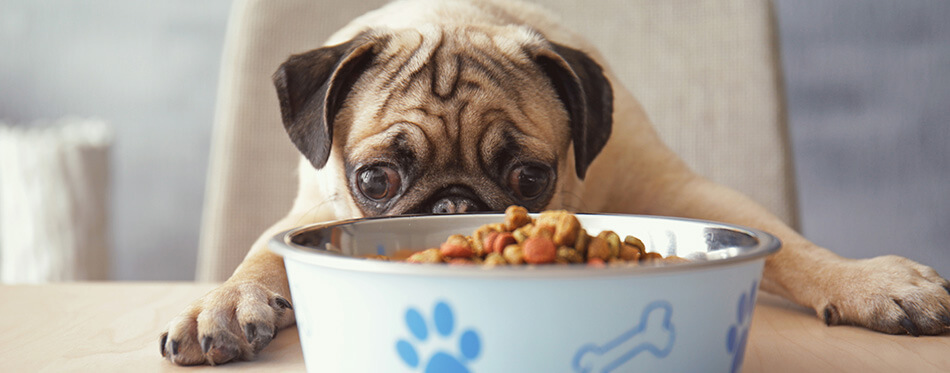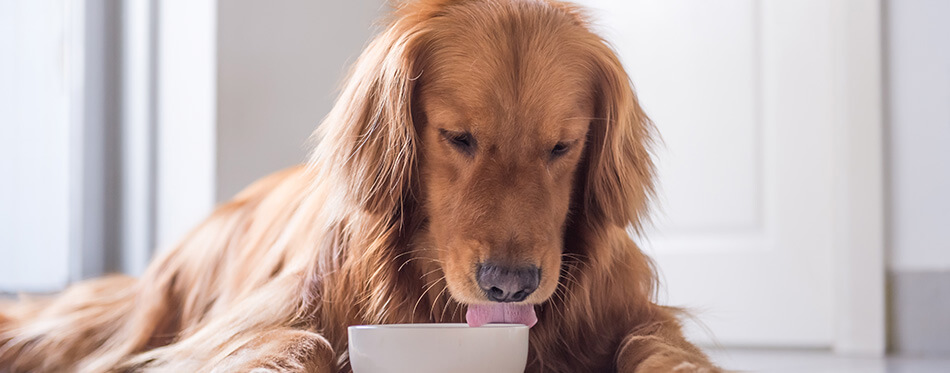Pet parents are guilty of over-thinking every little thing their pups do. But when it comes to your dogs eating too fast, sometimes it’s better to listen to your gut and slow them down. If you have a little speed-eater that treats their meal like an Olympic race, don’t fret! There’s no need to immediately call the vet. We’ve provided all the best solutions for you right here. This article will go through the ins and outs of pups eating too fast, when you should be worried, and what you can do to slow them down.

Why Does My Puppy Eat So Fast?
There are a couple of reasons why your puppy downs their kibble like their life depends on it. Each reason will be as unique as they are! Some of the most common reasons that your dog might eat too quickly include:
More Than One Dog
If there’s more than one dog in your home, you may notice your dog guarding their food bowl during mealtimes and eating their portion quickly. To them, this ensures their “competition” doesn’t get to their dog food before they can finish.
Meal Timing
Dogs are creatures of habit and meal times are important to them. They will remember what time their food is coming out and where it will be placed. However, if breakfast doesn’t come when they expect it to (and they will expect it!), you’ll soon find your pup speed-eating lunch so fast, it’s clear they believe they may never eat again!
Poor Nutrition
Some dogs eat their food incredibly fast due to poor nutrition or an underlying condition. If your dog is experiencing problems with iron deficiency, for example, they may feel hungry all the time and seek out food wherever they can. The good news is that this issue is easily remedied.
Illness
While less likely, dietary illnesses such as diabetes can cause malfunctions with your dog’s metabolism and digestive system. While these problems can be easily remedied with the right food or dietary supplement, if your dog eats too fast, then there may be other underlying health concerns. It could be worth giving your vet a call to sort through some of these concerns and seek advice. Once you rule some of the scarier concerns, you can more readily help your dog eat the right way! All you need to do is slow them down so that their stomach remains full and satisfied!
When To Worry About Dogs Eating Too Quickly
While most reasons why your dog inhales their food can be completely harmless and easily remedied, there are a few times when eating food too quickly is a sign of something more serious. Take a look at a few of our examples:
Dogs That Don’t Chew Food
If your dog doesn’t chew food, to the point where they’re choking, gagging, or heaving, then you know for certain they are eating too fast. This problem is easy for you to spot, so watch out for any of the obvious choking signs. This particular eating habit is potentially life-threatening, so just keep an eye, and ear, out for any of these negative signs. You wouldn’t want their love of food to cause any serious issues!
Gastric Dilatation-Volvulus
Dogs that continually eat their food too quickly can develop a condition called gastric dilatation-volvulus (GDV). This is a life-threatening illness that comes from the intestines or stomach twisting, and is caused by the excessive amount of air that gets sucked down with their kibble. This rare but unfortunate food bloat will stay inside their stomach and increase pressure on the surrounding internal organs. These air pockets can eventually lead to stomach rupture, which will make your poor pup go into shock. One sure sign your pup is experiencing symptoms of GDV is if you see them vomiting up foam, rather than food. If you are concerned that your dog has GDV, call your vet immediately and request an emergency appointment.
Canine Bloat
While not as serious as GDV, canine bloat can quickly become GDV if not treated quickly. This is where the stomach remains bloated for extended periods of time after eating. It is more common in puppies, but should usually subside as they get older and become more accustomed to their eating habits. Even though these situations are uncomfortable for your pup, they will still be able to bark while experiencing canine bloat. If it seems like they are barking more than usual, or whining on the spot, then I would give your vet a call.
You may also like our articles on Elevated Dog Bowls, Automatic Dog Feeders and Dog Bowls.

Tips and Tricks For How To Make Dogs Eat Slower
If you’re wondering how to slow down dog eating habits, follow these tips and tricks to help solve the amount of food your dog eats in a shorter space of time. Hopefully, you’ll see a big change in the way they eat!
Slow Feeder Bowls
Slow feeder bowls are a great option for most dogs, as they use raised surfaces within the bowl to cause your dog to sniff out and find the kibble in the gaps. This method slows their amount of food intake and forces them to think more about eating. These bowls also serve as little food puzzles that can help provide some mental stimulation for your energetic pup! With the slow feeder bowl, your pup will chow down right into slow town. It’s certainly going to take them more than a few minutes to lick the bowl clean!
Feeding Schedule
Sticking to a schedule can make a major difference in how your dog treats their meal. As mentioned earlier, dogs are creatures of habit and want to be certain when their next meal is coming. Keeping to a stricter feeding schedule will give your dog more security and keep them from feeling like each meal is their last. Not sure how to make a mealtime schedule? Simply feed your dog at regular intervals, same time each day, with the similar amounts in their food bowl each time. If you do this, your dog will be waiting patiently for their food at the exact time you intend to feed them! But be warned: If you don’t deliver that food immediately, they may remind you with a hearty bark and a sad look!
Cookie Sheets
If you can’t find a good slow feeder bowl or don’t want to waste time cleaning it out, then try spreading their food across a cookie sheet instead! This method is cost-effective and stops your dog from eating too fast, as they have to lick up every piece. Just make sure you spread it equally across the entire sheet. That way, it will make your dog take longer to lick up the food or nibble it away from the surface. It should slow them down considerably and save you from having to worry!

